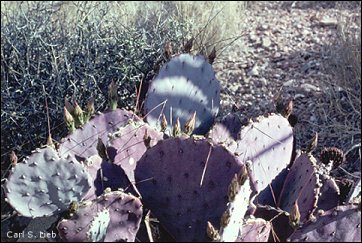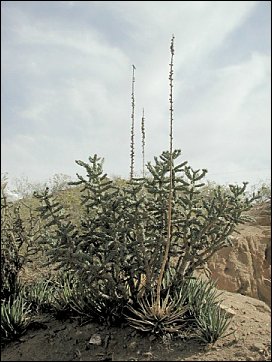
Novices sometimes wonder why two plants seemingly having little in common are placed in the same genus, implying that they are very close relatives. A favorite Chihuahuan Desert example is the prickly pear and cholla cacti, both usually placed in the genus Opuntia. The prickly pear plant looks like it's made up of flapjacks joined together, with its stem segments flattened and usually oval to nearly round. The cholla, however, has linear segments, their appearance giving rise to one of the common names: walking-stick cactus.
In classification, not all features are created equal when it comes to
trying to figure out who's related to whom. With plants, the flowers usually give
more reliable information than other parts, and so it is that prickly pears and chollas
are placed together. Classification is still partly a matter of judgement, however.
There are those taxonomists who believe there are enough differences within the
Opuntia to split it into three genera: prickly pears, chollas, and club chollas.
For once, it'd be nice to have science and common experience on the same
page.
![]()
Contributor: Arthur H. Harris, Laboratory for Environmental Biology, Centennial Museum, University of Texas at El Paso.
Desert Diary is a joint production of the Centennial Museum and KTEP National Public Radio at the University of Texas at El Paso.

Opuntia macrocentra, Indio Mountains Research Station, Hudspeth Co., TX. 1 Apr 1995. Photograph by Carl S. Lieb.

Cholla cactus (Opuntia sp.) with Lechuguilla. University of Texas at El Paso campus. Photograph by A.H. Harris.
![]()
Dimmitt, M. A. 2000. Cactaceae (cactus family). Pp. 183-218, in A natural history of the Sonoran Desert (S. J. Phillips and P. W. Comus, eds.), Arizona-Sonora Desert Museum Press, Tucson.